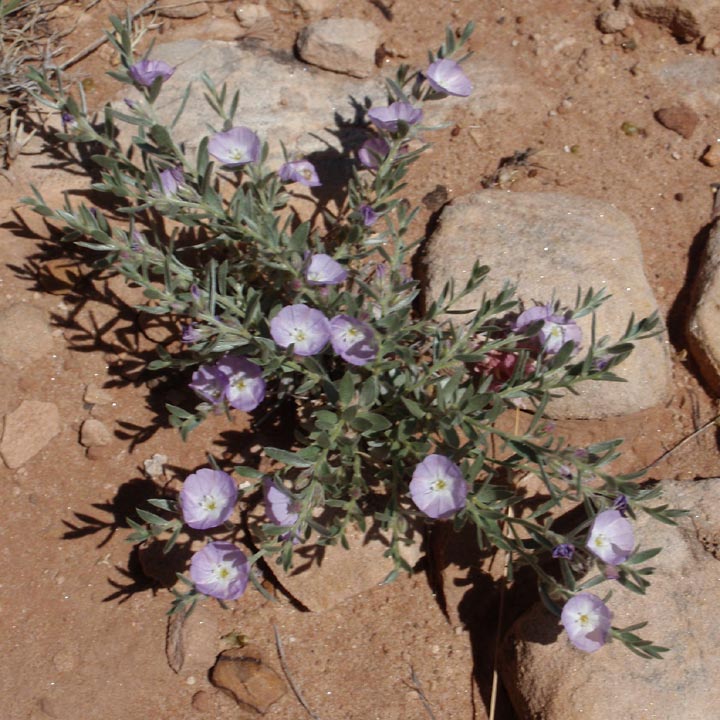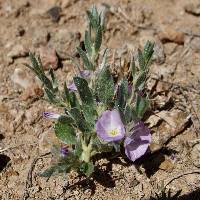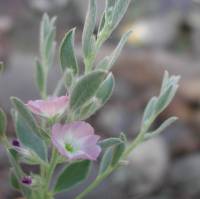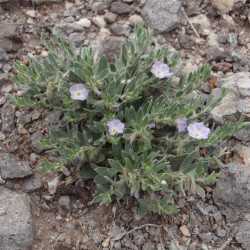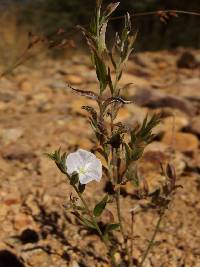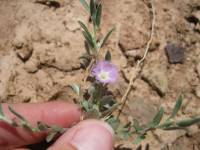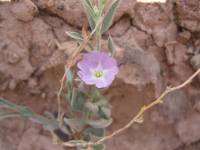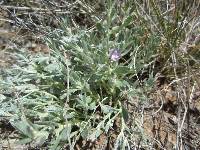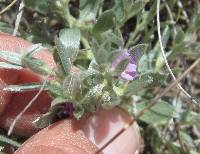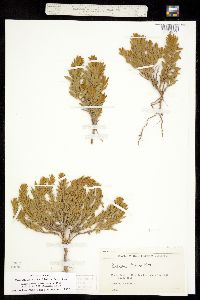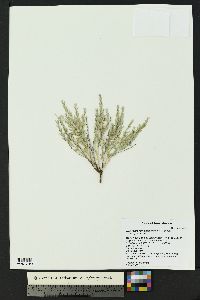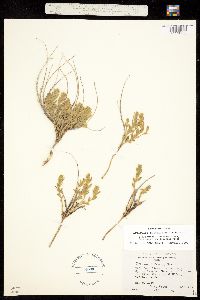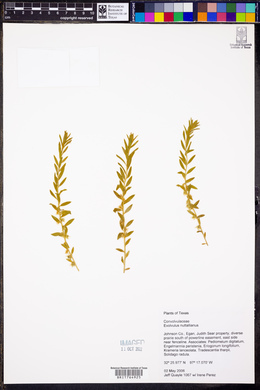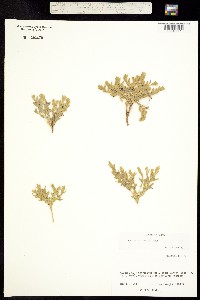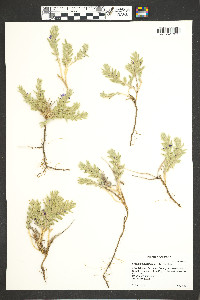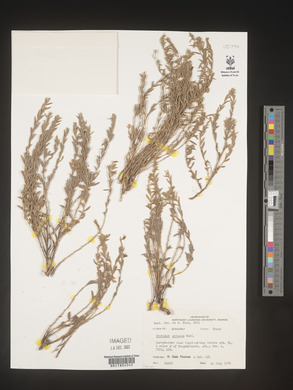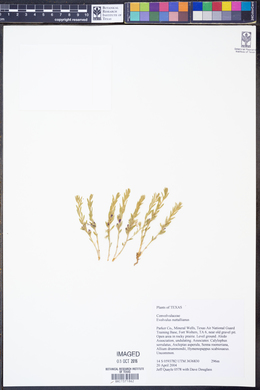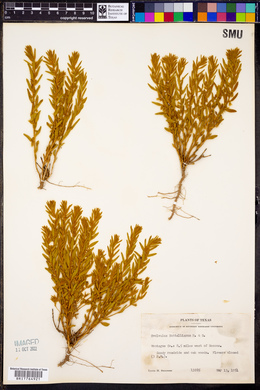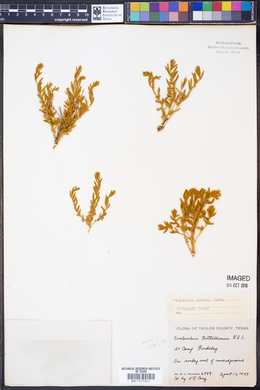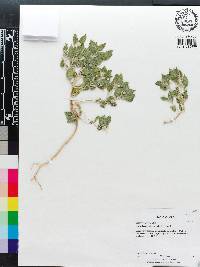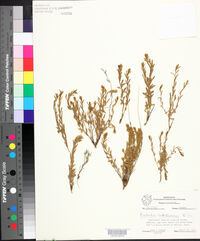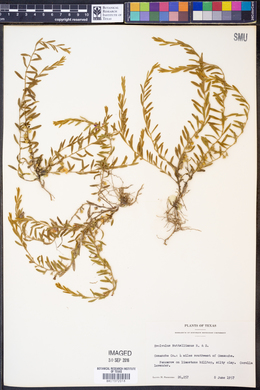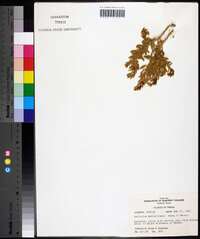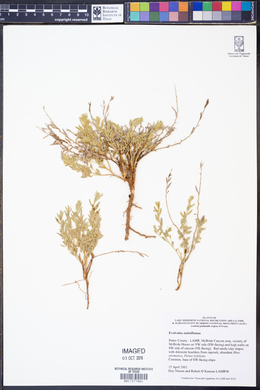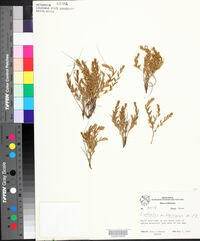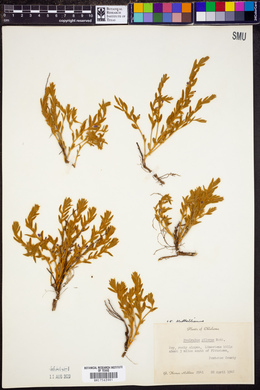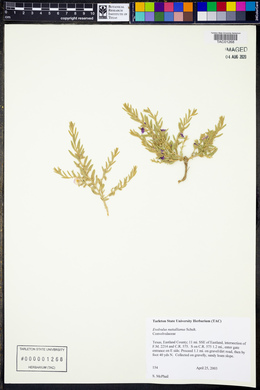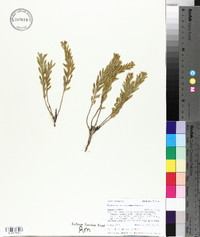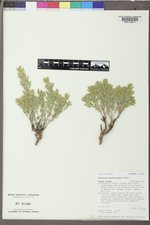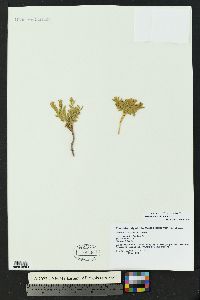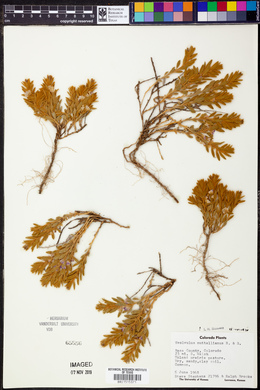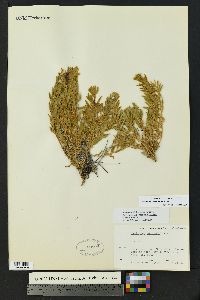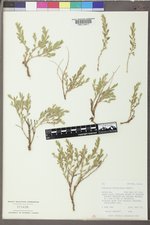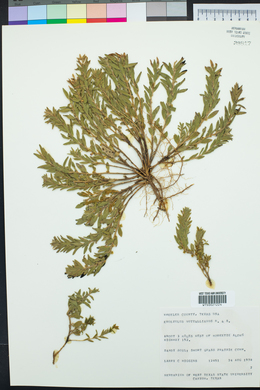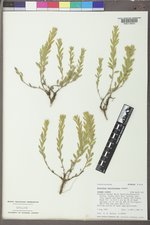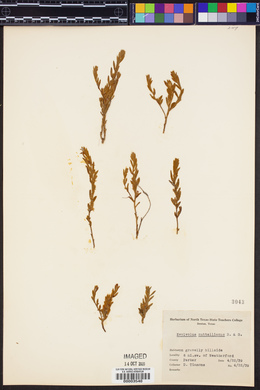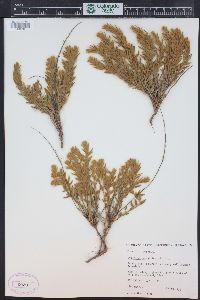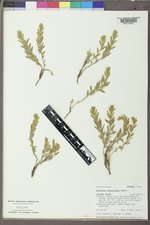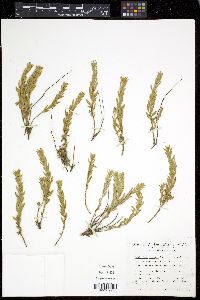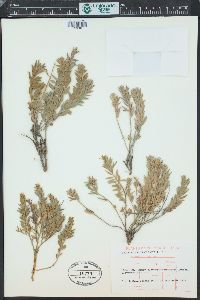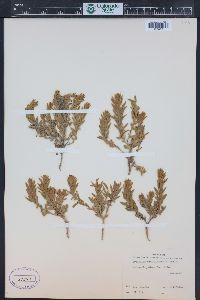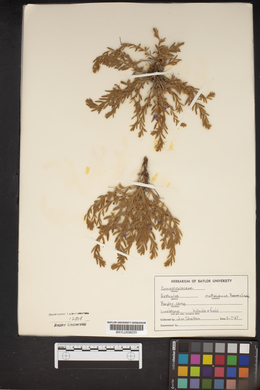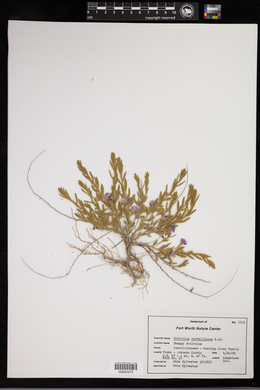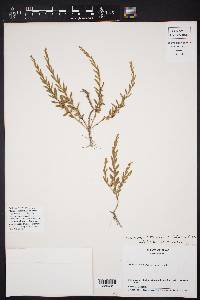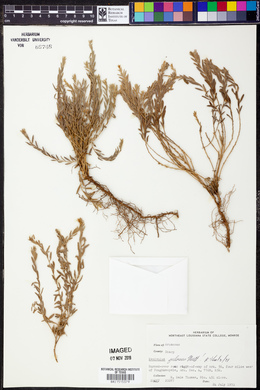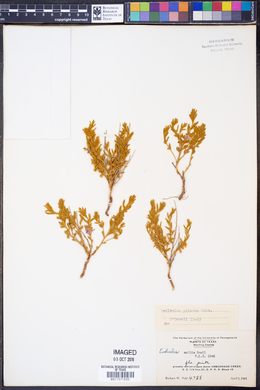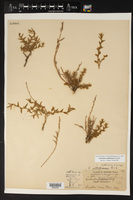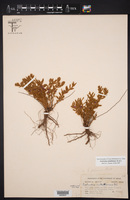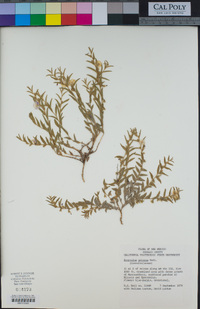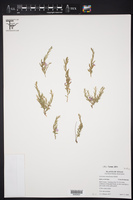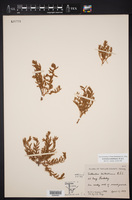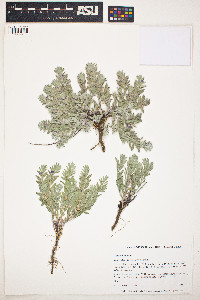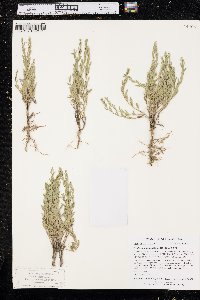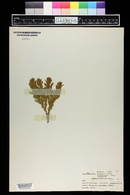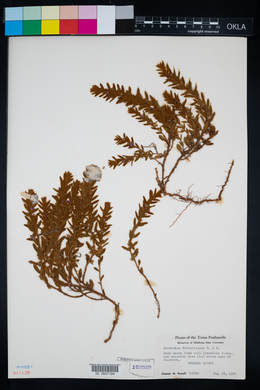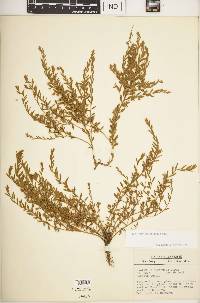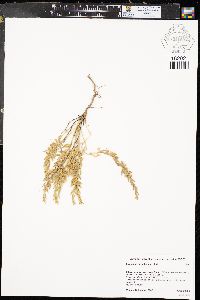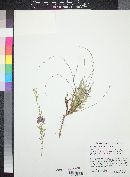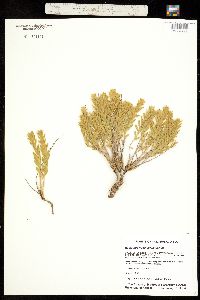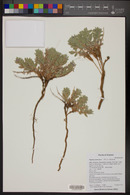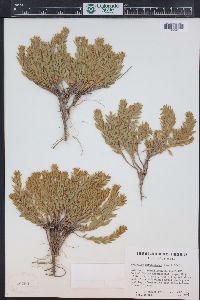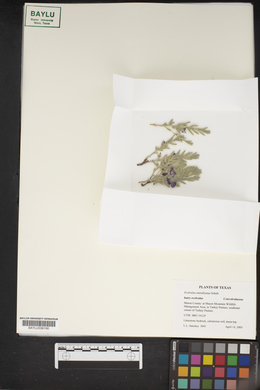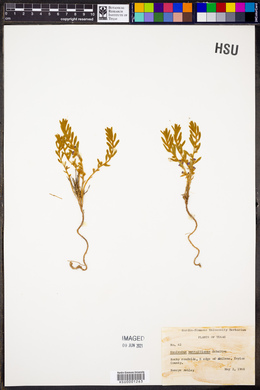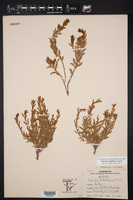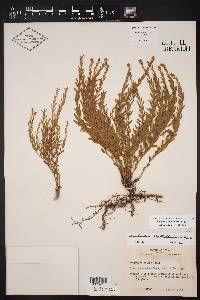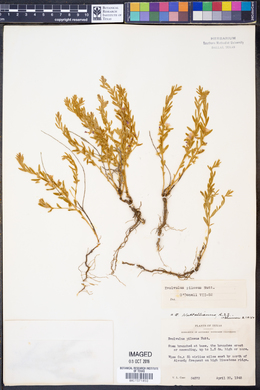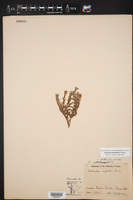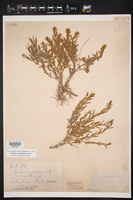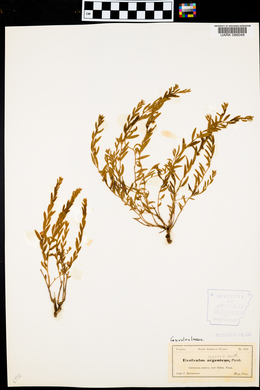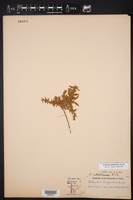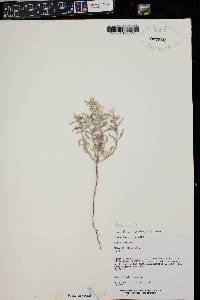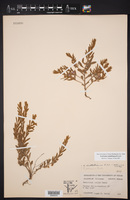
|
|
|
|
Family: Convolvulaceae
shaggy dwarf morning-glory, more...Shaggy Dwarf-Morning-Glory, blue-eyes, prostrate evolvulus, shaggy dwarf morningglory, silver wild morningglory
[Evolvulus argenteus Pursh, moreEvolvulus pilosus Nutt.] |
Plant: Suffrutescent herb; stems several, erect to ascending, 10-15 cm tall, densely spreading-pilose with an indumentum of ferrugineous, brown, fulvous or gray color Leaves: linear-oblong, narrow-lanceolate to narrow-oblanceolate or rarely oblong, 8-20 mm long, 1.5-5 mm wide, entire, attenuate basally, acute to obtuse apically, densely pubescent on both surfaces; petioles short or absent INFLORESCENCE: single flowers in axils over whole length of stem; peduncles short or absent, stout Flowers: on pedicels 3-4 mm long, reflexed in fruit; bracteoles subulate, 1-4 mm long; sepals lanceolate to narrowly lanceolate, long-acuminate, 4-5 mm long, spreading-villous; corollas rotate to broadly campanulate, 8-12 mm wide, entire, purple or blue; anthers 1-2 mm long, oblong, basally auriculate, the filaments twice as long as the anthers; ovary globose Fruit: FRUITS ovoid, about as long as sepals, glabrous. SEEDS (1-)2, brown, smooth Misc: Sandy and rocky prairies and plains, chaparral, pinyon-juniper and oak woodlands; 800-2450 m (2700-8000 ft); May-Jul REFERENCES: Austin, Daniel F. 1998. J. Ariz. - Nev. Acad. Sci. Convolvulaceae 30(2): 61. Perennial herb 10 - 20 cm tall Leaves: crowded, alternate, ascending, stalkless, small (1 - 2 cm long), lance-shaped to narrowly oblong, longer than wide, non-toothed, hairy. Flowers: many, singly in leaf axils, mostly stalkless, blue, small (around 1 cm tall and wide), broadly funnel-shaped. Sepals: five, about 0.5 cm long, narrowly lance-shaped, and covered with long soft hairs. Petals: five, but fused into short funnel with very ends flaring and appearing wavy-edged. Stamens: five, attached to inside top of petal tube. Pistil: with one, two-chambered, superior ovary; two styles, each branching in two near the base; and ending in two pairs of linear stigmas (four total, one per style branch). Fruit: two-chambered, four-valved, one- to two-seeded, egg-shaped capsules atop short, deflexed stalks. Stems: several, erect or ascending, densely hairy, and arising from a central thick root. Similar species: Evolvulus nuttallianus is unlike other members of the Convolvulaceae family in the Chicago Region because its flowers have two styles which each branch into two and each of those branches ends in a stigma, so there are four linear stigmas per flower. In addition, other members of the family tend to be much larger with larger flowers, and much larger, obviously stalked leaves. Flowering: June to July Habitat and ecology: Introduced from farther south and west, this species has only been reported in one locality near a gravel pit. Occurence in the Chicago region: non-native Notes: This plant is native to dry prairies and barrens south of the Chicago Region from southeast Tennessee, into the Ozark region of Missouri, and west into the Dakotas and Arizona. Author: The Field Museum VPAP (Austin 1998), Intermountain Flora (Cronquist et al. 1984), Allred and Ivey 2012 Duration: Perennial Nativity: Native Lifeform: Subshrub General: Perennial herb, 10-15 cm tall; stems several, woody and much branched near the base, erect to ascending; herbage densely spreading-pilose, the hairs tinting the stems brown to grayish. Leaves: Alternate and distichous (2-ranked) along the stems, sessile or on very short petioles; blades oblong, narrowly oblanceolate, or narrowly lanceolate, 1-2 cm long and 2-5 mm wide with entire margins, densely pubescent on both surfaces. Flowers: Small but showy and lavender, solitary in leaf axils; sepals 5, narrowly lanceolate, 4-5 mm long, hairy; corollas rotate to broadly bell-shaped, 5-9 mm long and 6-10 mm diameter, purple, blue, or lavender. Fruits: Capsules ovoid, about as long as sepals, glabrous; containing 2 smooth, brown seeds. Ecology: Found in sandy and rocky soils, on slopes and plains, from 2,500-8,000 ft (762-2438 m); flowers May-July. Distribution: MT south to AZ and east to TX; south to c MEX. Notes: Our Evolvulus species are often low-growing, have alternate, usually linear to ovate, entire leaves; blue, white or purple flowers often the shape shallow bells or funnels (salverform, rotate, funnelform) that arise from leaf axils; and capsules. E. nuttalianus is a perennial, with few to many short (10-15 cm tall) erect or ascending stems which branch mostly from the base (not as nest-like as E. arizonicus and E. alsinoides and not as prostrate as E. sericeus); dense, long, appressed silver hairs on both sides of leaves (fewer hairs on the tops of leaves in E. sericeus) giving the plant a more silvery appearance than other southwest species; very short to no stems hodling up the flowers (peduncles)(longer than leaves in E. alsinoides and E. arizonicus); blue to purple flowers almost 1 cm wide. Often easily overlooked when not in flower, but with its erect stems, alternate leaves and densely pilose, silvery leaves it is distinct. Ethnobotany: Used as a snuff for itching and sneezing in the nose. Etymology: Evolvulus comes from the Latin evolvo, meaning to unroll, while nuttallianus is named for the English botanist Thomas Nuttall (1786-1859). Synonyms: Evolvulus argenteus, Evolvulus pilosus Editor: SBuckley 2010, FSCoburn 2015, AHazelton 2017 Erect or ascending, 1-2 dm, densely hairy, lvs crowded, ascending, lanceolate or narrowly oblong, 1-2 cm; fls solitary in the axils, sessile or on pedicels shorter than the narrowly lanceolate, villous sep; cor blue, broadly funnelform, 1 cm wide, its margin nearly entire; pedicels deflexed in fr; fr ovoid, 1-2-seeded. Dry prairies and barrens; N.D. to Mont., s. to Mo., Tenn., Tex., and Ariz. May, June. (E. argenteus Pursh, not R. Br.; E. pilosus) Gleason, Henry A. & Cronquist, Arthur J. 1991. Manual of vascular plants of northeastern United States and adjacent Canada. lxxv + 910 pp. ©The New York Botanical Garden. All rights reserved. Used by permission. |
|
|
|

